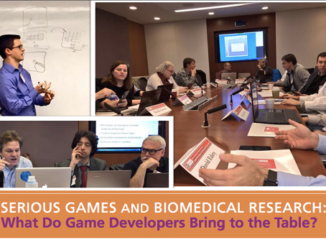
Games, Science, and Citizen Science: An interview with Vito Servedio, Institute of Complex Systems
The Citizen Science Association is re-energizing a series of interviews with citizen scientists and citizen science enthusiasts. This month, Çiğdem Adem interviews Dr. Vito D.P. Servedio. Vito is a researcher in Physics at the Institute of Complex Systems (ISC-CNR) and the Sapienza University of Rome, Italy and works in the field of Complex Systems with particular attention to social dynamics, information dynamics and innovation dynamics. He was the scientific coordinator of the Sapienza Unit for the European Project EveryAware which stands for Enhance Environmental Awareness through Social Information Technologies.
Vito, in recent years, the use of web-based games for research purposes is increasing. Can you explain why? What is the link between games, science and citizen science?
Internet has changed the way information has spread in the world since its first massive usage at the end of the last century. Today, in 2016, 46% of the whole population of Earth is accessing Internet, with an impressive 80% in developed countries. Such a huge audience has opened the way to a multitude of diverse activities ranging from commercial to institutional applications. It is, therefore, unavoidable that scientists also take advantage of this. Initially, the scientific activity in the web was confined to mere dissemination of results and to educational purposes, but slowly, the scientific community realized that the “wisdom of the crowd” could be used to carry out true scientific experiments.
The major problem afflicting experiments is that they are usually felt as boring for an average Internet surfer and the user participation is traditionally very low, limited to rare occasional visits. Here the play aspect of experiments comes handy i.e. in raising users’ participation. In return, by participating in the experiments, users become more and more attached to the topic and develop a sort of proficiency that can be used to make a successful and long living experiment.
What are the challenges and solutions regarding validity about web-based citizen science experiments?
One of the problems is that of “scalability”, a technical term that stands for “easily expandable”. Although scalability represents a real bottleneck of any web-based citizen science experiment, it is very often overlooked. Let me explain its importance with an example. A lot of citizen science projects are based on the validation of selected experts, who, for example, have to judge the quality of user interpretation of data (e.g. species recognition from given pictures). Now, let’s say we have 1,000 users and we need 10 experts. When we hopefully reach 1,000,000 active users we shall need 10,000 experts. Otherwise, we will not be able to check the incoming data. Of course, we will not be able to involve 10,000 experts easily and this originates a scalability problem, i.e. the experiment cannot be continued unless we allow a very coarse data check with the risk of losing reliability. By enhancing user’s proficiency, instead, we will have experts for free. Users’ proficiency can be the result of large individual participation that we can achieve by increasing the amusing content of experiments.
This is not the whole story. Actually, by training users to become experts we only shifted the problem, because we might not be able to train a sufficient number of experts in the required time. Think simply what would happen if in a week, we increase our users from 1,000 to 1,000,000. We would not have enough time to train the required number of experts by relying on their diligent participation and the experiment would fail. To solve this problem, we can use an automatic validation embedded in the game-experiment, where two users/players compete or collaborate with each other to solve a specific problem.
Can you specify by giving an example?
The famous ESP-game of Luis von Ahn is a paradigmatic example by which a huge number of pictures in the web were labeled in a reasonably short time. Briefly, two random players were paired and exposed to the same picture extracted from the web. These two players did not know each other and could not communicate. Their task was to agree on a tag word that would best represent that image by entering label words in a text box as quick as possible. When both entered the same word, not necessarily at the same time, they would be rewarded with points. As a result, images were labeled a lot of times with their labels validated by users’ common guesses. ESP-game is not an example of pure citizen science, i.e. there is no transfer of knowledge to users (such games are called GWAP, Games with a Purpose). Nevertheless, it gives a perfect idea of amusement connected with massive participation, scalability and self-validation.
Can you give already existing examples of games based citizen science?
It depends on how we define a game. What we can find around are games where the competition relies in solving puzzles to achieve the best result and raise one’s own overall ranking. In that sense, I can cite the pioneer “Foldit“, a successful project in terms of scientific results, which was released in 2008. More recently, in year 2010, appeared “Phylo” and “EteRNA“. These three scientific games leverage the ability of users to solve puzzles. “Foldit” is about finding the structure of a protein given its amino-acid sequence; “Phylo” is about finding alignments of DNA regions possibly connected with genetic diseases; “EteRNA” deals with the folding properties of RNA. Another notable example is “Fraxinus” released in August 2013 as a Facebook puzzle game – about identifying which ash tree genes are responsible for a certain fungus resistance – that had all its puzzles solved in two months with 40,000 people playing from 126 countries. Away from biology, “Quantum Moves” of Aarhus University connects the movement of a player’s mouse to simulate the laser beams used in a real laboratory of quantum computing.
A true competitive or collaborative game where players interact with each other in real time to address citizen science related problems did not exist until recently. In our group we set up such games, e.g. the XTribe “Joe’s City Race Duo” and the “Nexicon Duo” where in the former, two players compete to find the best trajectory in a city with traffic, while in the latter players collaborate to find word associations to a given stimulus word. Both games are hosted in the XTribe platform, which we conceived to serve as a container of scientific games, taking care of those necessary, but annoying procedures is common to any web-based game (user registration, user pairing, user filtering and instance creation). “Blindate” is also a game hosted in XTribe, where two players have few attempts to find each other in a city and the scientific outcome is related to the discovery of the so called focal points of a city. Obviously, due to the fast rate of growth of gamification of citizen science, many other scientific games may have appeared of which I am not aware.
And the classic question comes. How did your interest in citizen science begin?
It was a consequence of my activity in the EveryAware Project. At the beginning, we intended to build a sensor box by assembling cheap air quality sensors to have a sort of electronic nose to sample the environment. The idea was that ordinary people could measure the level of pollution themselves, getting more aware of their environment. I confess that when we submitted the project proposal we thought it would be very hard to receive funding. It was really innovative: the term “citizen science” was not even coined yet and the idea of letting people sample the environment was unpopular among stakeholders, and still is, by the way. At the end, EveryAware was a great success. We did not start from scratch since we had some experience with the Tagora Project, (http://www.socialdynamics.it/tagora/) where we studied how people unconsciously cooperate in tagging resources on the internet.
In EveryAware, cheap sensors were the key ingredients that would allow people to afford contributing to the sensor box expenses. That would allow a pervasive monitoring of the environment. The low quality of sensors would balance the better statistics one gets with thousands of users. For this purpose we also developed a thematic international web-based game, still running right now (http://www.everyaware.eu/APIC/).
What is the interest of young people in citizen science? What is the role of web-based games in engaging young people in citizen science?
When talking about games we think immediately of young people, but that is not quite correct. Data show that 26% of players are over 50 years old, 47% with an age between 18 and 49 and 27% below 18 years old (data from the Entertainment Software Association, ESA, 2016). Surely, young people, because of their enthusiasm are the preferred target of citizen science and the “gamification” of an experiment can make science less harsh and more digestible. Undoubtedly, young people are more prone to test innovations and will resonate more to web based scientific games as well as to dedicated smart phone applications. Of course, traditional schools can be a good channel to convey this future new discipline to young people, but first we need to catch the attention of their teachers.
That is interesting. How do you see the games based citizen science in 5 years? How would this develop?
Five years is a huge time span compared to the pace of innovations. I think web-based experiments will be parallel to smart phone applications and in general to new ICT tools. Mobile phones are getting more and more complex. The industry will try to make them more appealing by embedding different sorts of sensors. I see a virtuous feedback between the web, science and our mobile devices. The main issue will be to enhance user participation to overcome the self-sustainability threshold and afterwards the experiment would keep going by itself. Therefore, the playful component of science will have an important role. On the other hand, we have to cope with problems related to multidisciplinary skills. To produce an appealing game-experiment one needs to hire professional programmers, which has a cost in terms of both funding and psychological pressure to overcome the traditional and conservative views of science.
Is there anything else you would like to add?
I wish to thank my collaborators who have been taking active part in my journey into the Citizen Science: Prof. Vittorio Loreto, Dr. Francesca Tria, Claudio Cicali, Pietro Gravino Elisabetta Falivene and Cesare Bianchi.
The interview was originally conducted by Çiğdem Adem for citizenscience.org
http://citizenscience.org/2016/09/22/games-science-and-citizen-science-an-interview-with-vito-servedio-institute-of-complex-systems/
Çiğdem is an environmental sociologist who worked on nature conservation projects in Turkey implementing participatory methods to work with local communities. While working at the European Environment Agency on lay, local, traditional knowledge and citizen science, she initiated a citizen science newsletter that included interviews with citizen scientists. She is enthusiastic to continue with the interviews at the Citizen Science Association with the hope that they are inspirational to the readers. She tries to reflect the diversity across the world and across various themes.


